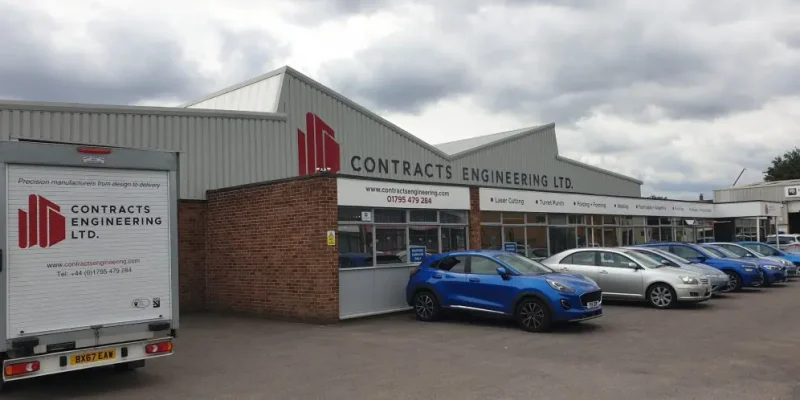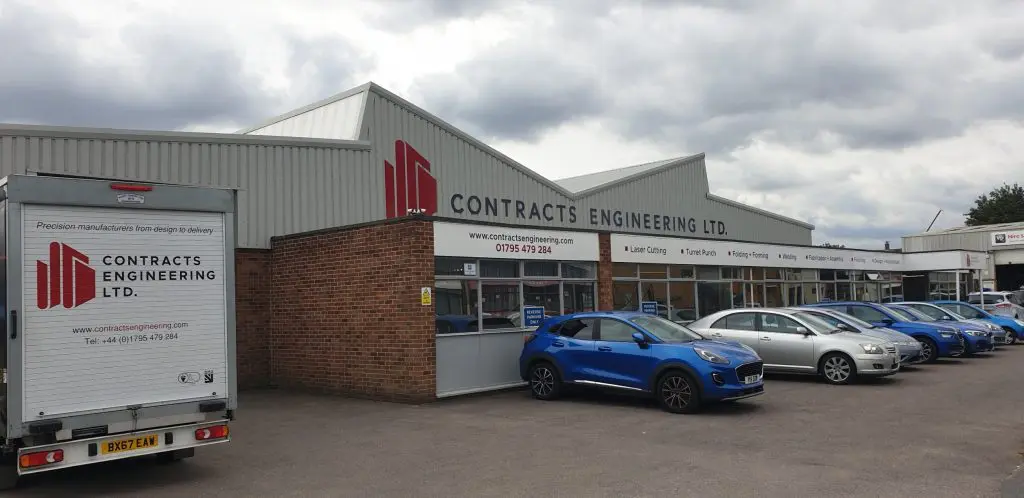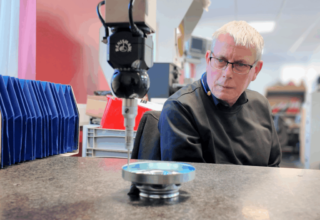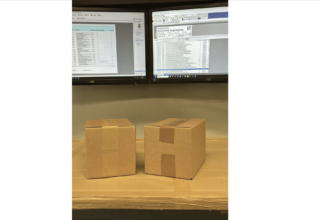
When Contracts Engineering pivoted to a new business strategy, welding robots was a key ingredient to massively grow the manufacturing business. This is the story of how it happened.
There were no robots, and nothing was automated when Troy Barratt bought his first manufacturing company – Contracts Engineering Ltd. – in 2012. All sheet metal work and metal fabrication were done manually, and paperwork was abundant.
“Everything took many more steps than it needed to. Processes were tedious, and it was easy to make mistakes,” says Troy Barratt, who serves as CEO of the company and its owner parent, BAMUK Group.
In the following years, he and the team would take the company through a massive transformation involving robots, automation, and a new business strategy. Today, 12 years later, the company has grown its turnover nearly six-fold and employs close to 40 people and three robots at its facility in Sittingbourne, South East England. When including two other group companies, BAMUK Group now employs approximately 70 people compared to around 20 in 2012.
“It all started with a great team and finding the right strategy – in which robots and automation played a key role,” says Troy Barratt.
Scaling the company depended on automation
The first step in turning the company around was – counterintuitively – to say no to certain clients. The contract manufacturer had previously served anyone who came knocking on the door with a need to manufacture some “random bits”, Troy relates. But, by focusing exclusively on OEM and tier 1 manufacturing clients, the company would start taking in larger orders and gain a stronger momentum by streamlining the business from sales to engineering to supply plan and production.
“This strategic focus helped us grow and made us able to talk to clients about quite big opportunities,” Troy Barratt says.
With scaling the company, however, the bottlenecks in the manual production setup at the time became obvious. Integrating with large, global supply chains required the company to reduce unneeded processes and start automating repetitive tasks. The first eight years of that automation journey didn’t involve any physical robots but focused on the basics: Updating older equipment and using software plus team training to automate administrative and managerial processes.
“There is much talk about AI right now, but really, there’s quite a lot of business automation that can be done with much simpler software – from invoicing to repeat orders, quote updates, production planning and scheduling – and then building all that into a system,” says Troy Barratt.
As orders kept growing, Contracts Engineering soon hit another bottleneck: production staff. The volume of parts in each order reached a point where it was difficult to keep up with the clients’ expected lead times with manual labor alone.
“We had one contract that got really big with many parts requiring very simple and repetitive welding. It was just too much to manage manually; as people went on holidays, schedules fluctuated, and we would rotate staff to other projects. It wasn’t really an option to cross-train several welders for this task and expect them to stay on it permanently,” Troy Barratt says, adding:
“It just became blindingly obvious we needed a robot.”

Diving into the robot market for the first time
Troy and the team quickly realised that getting the first robot was easier said than done. Like many other manufacturers in the UK, the staff didn’t have any previous experience with robots and automation and had to learn everything from scratch.
The first step was finding an integrator to put together a solution. Troy Barratt started visiting trade shows and engaging in discussions with many different integrators. This involved a lot of work with signing NDAs, sharing CAD files of the products, and going through the manufacturing process and potential solutions – while learning how to maneuver the market. The whole search process ended up taking about a year.
“When you start from zero, it just takes time. There are many integrators, and they all swear to specific brands, which can be challenging to navigate,” Troy Barratt says, elaborating further:
“We tried to be very open with them, saying: ‘We know how to weld, and we’re good at manufacturing – help us understand what we can and can’t do’.”
Contracts Engineering’s Production Manager chose to engage in deeper discussions with five integrators to get a range of opinions on how to automate the welding job. He and Troy then selected to continue negotiations with two that he felt best understood his business and the task – and were most customer-focused:
“What I liked is that they were also quite open to telling us what we couldn’t do. They helped us understand which of our products wouldn’t be feasible to weld with a robot,” Troy says.
From there, he got into deeper discussions with the remaining two integrators about everything from how they would estimate the cycle times to what fixtures they would use and how they would train the staff on operating the robot. When the details and costs were cleared out, Troy Barratt had to make a tough decision.

Buying the first robot involved a calculated bet
It became apparent during the discussions with the integrators that Contracts Engineering wouldn’t be getting a great return on their robot investment at first. The cost of the robot welding system amounted to just under £200,000. Then, there was training, fixture design and development, as well as extraction, electric and other fit-out requirements. The robot would pay itself off, Troy notes, but it wouldn’t be generating much additional cash flow for the company on the contract that would be moving to the robot cell. So, the team had to make a calculated bet: That Contracts Engineering could find more work for the robot, which would eventually provide a return on the investment.
“The decision to get our first robot came out of a necessity and the confidence that we’ll just have to find more work for it. We believed manufacturing would be coming back to developed countries and that automation would allow us to be competitive,” says Troy Barratt.
Fast forward four years, and the bet turned out to more than pay off. Not only was there more than enough work for the first robot, but also for two additional welding robots, including a collaborative robot or “cobot” in one of the manual welding bays. Today, half of everything the company quotes involves robotic welding as part of the job. And the impact on the business is tangible:
“Since our first robot investment, we’ve more than doubled the business. There’s quite a lot of that business that we only have because we can do robot welding. With the amount of welding we do now, we could never manage that many welders,” Troy Barrat says, elaborating:
“Welding is the hardest to upskill, train and rotate people to because of the nature of your welding versus running a CNC punch, laser, or smaller CNC machine. So, welding was what we needed to automate the most.”
The robots made work more interesting
The welding robots are used for the most repetitive and ‘boring’ tasks, which has several benefits according to Troy Barratt. For one, they vastly speed up the throughput time for certain welds. Welding a chassis might take up to 4.5 hours of manual welding time per fixture, he says, but the robot can cut the time down by around 50%.
“And we believe we might be able to get it down to below 50%,” Troy adds.
While the robots don’t make better welds than fabricators or welders, they do have another advantage: consistency.
“If you do 1,000 welds a day, you’ll get tired and distracted at some point. A robot will do it exactly the same way every time. I don’t know how you can consistently weld anything of volume without robots unless it’s a very specialized type of weld,” Troy Barratt says.
This does not mean, however, that the robots are taking any jobs away from the human welders. On the contrary, the welder-fabricators are still working at the company, and the robots have only made work more interesting for them, Troy mentions. Upskilling them to focus on more complicated, high-end welds inspires them to stay at the company, he says:
“No one likes doing the same weld day in and day out. They will get bored and move somewhere else. So, people understand that robots are not about replacing them but giving them variety in their work.”
Troy’s advice: Get help, learn, and be patient
The robot’s success at the company didn’t happen overnight. It took some trial and error for the company to work out how to get the robots to live up to their potential. But from the beginning, Troy insisted that his staff learned how to work with and program the robots.
“It was important for us to build in-house expertise, so we didn’t depend completely on a 3rd party for programming. If we’re too reliant on others, it can get expensive and be hard to stick to lead times,” Troy Barratt says.
When choosing the first integrator, he found one that could teach his team the basics and provide them with aftermarket training, service, and support. Over time, both CNC operators and welders at the company started learning how to use, program, and troubleshoot the robots. Besides becoming more self-reliant, the team also discovered another unintended benefit of learning to work with robots – it brought the fabricating and CNC side of the company closer together, Troy accounts:
“It developed into this awesome ecosystem of CNC operators and welders working together on the robots. It gave them greater variety in their work and helped them evolve into new roles,” he said and gave a few examples: A welder who learned how to program the robot started programming other machines. And a CNC operator, who spent a lot of time with the welding robot, learned how to weld himself.
“Getting robots was a commercial decision at first. But it’s fantastic to see how it’s also helped people learn different skills and get a more rewarding work life,” Troy Barratt says.
His advice to other businesses that want to get started with robotics? Be patient, learn – and get help:
“Some things just take time when you do it for the first time. Just be patient and keep learning, so you build up your in-house expertise,” he says, concluding with a tip:
“When we started, I wish we would have known where to get third-party, brand-agnostic support – like the one HowToRobot provides. Today, I always tell people at the start of their journey to get as much impartial advice as possible.”













